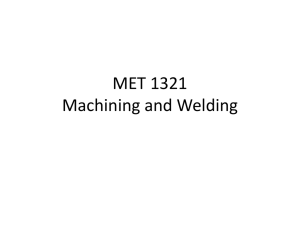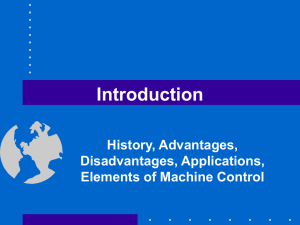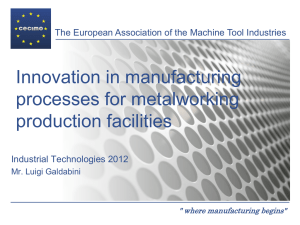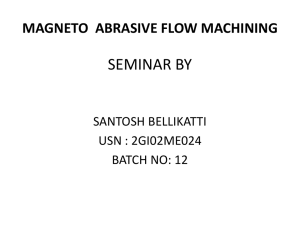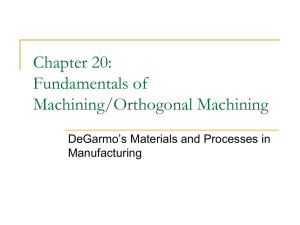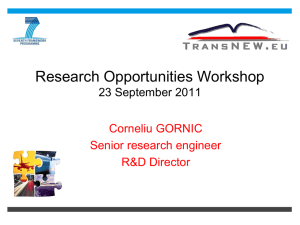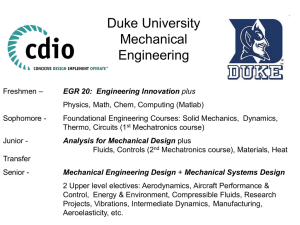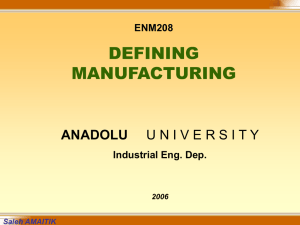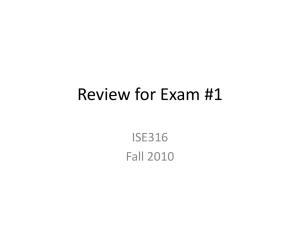MT-284 MANUFACTURING PROCESSES
advertisement
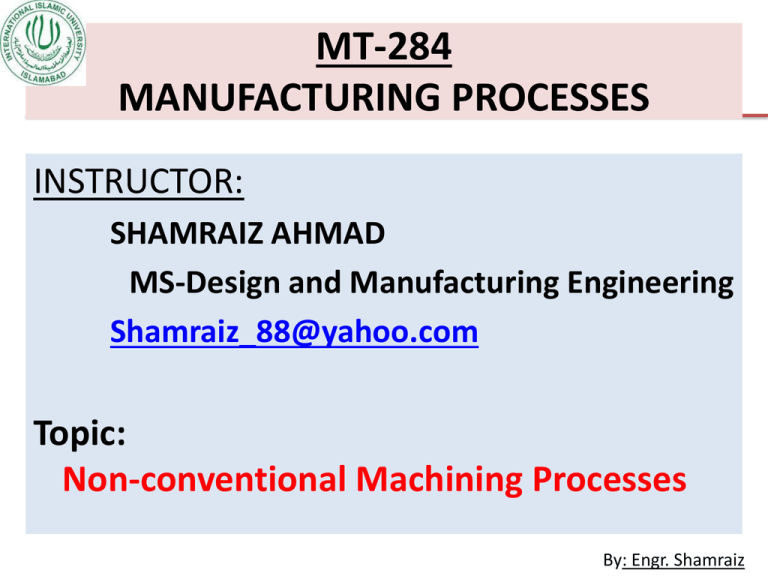
MT-284 MANUFACTURING PROCESSES INSTRUCTOR: SHAMRAIZ AHMAD MS-Design and Manufacturing Engineering Shamraiz_88@yahoo.com Topic: Non-conventional Machining Processes By: Engr. Shamraiz This Lecture • Non-conventional machining processes – Introduction to Non-conventional machining – Need of development of NCM-processes – Classification of NCM-Processes • • • • Mechanical energy based processes Electro-chemical processes Thermal energy based processes Chemical energy based non-conventional By: Engr. Shamraiz Introduction Non-conventional Machining (NCM)Processes • Conventional machining processes (like turning, drilling ,milling) use a sharp cutting tool to chip from work piece by shear deformation. • Non-conventional machining processes refer to group of processes that removes excess of material by various techniques involving different forms of energies ( like mechanical, thermal, electrical, chemical or combination of these energies). They don’t use sharp cutting tool like conventional machining. By: Engr. Shamraiz Need of NCM-Processes 1. To machine newly developed metal and non-metals having special properties ( high strength, high hardness and high toughness) 2. To machine complex part geometries which are difficult or impossible to machine with conventional methods such as internal and external profiles, or small diameter holes 3. The need to avoid surface damage as stresses are created in conventional machining processes 4. Surface finish or tolerance better than those obtainable conventional process. 5. The work piece is too flexible or slender to support the cutting or grinding forces. 6. These approaches are specially used in aerospace and electronics industry which is developing at fast pace. By: Engr. Shamraiz Classification of NCM-Processes These processes are often classified according to form of energy used to affect material removal. According to this criteria there four major types: i. ii. iii. iv. v. vi. vii. viii. ix. x. xi. xii. xiii. xiv. Ultrasonic machining Mechanical energy Water jet cutting Abrasive water jet cutting based machining Abrasive jet machining Electrochemical machining Electro-Chemical Electrochemical deburring and grinding based Electrical discharge machining Electrical discharge wire cutting Electron beam machining Thermal energy Laser beam machining Based processes Plasma arc cutting process Oxyfuel cutting process Chemical milling, blanking and engraving Chemical energy based Photochemical machining By: Engr. Shamraiz Classification & Overview of NCM By: Engr. Shamraiz A. Mechanical based NCM-Processes • Mechanical energy in some form different from action of cutting tool. • For example, erosion of work material by a high velocity stream of abrasives, fluids or both. • Types under this category are: i. ii. iii. iv. Ultrasonic machining Water jet cutting Abrasive water jet cutting Abrasive jet machining By: Engr. Shamraiz 1. Ultrasonic Machining Definition: It is a mechanical based non-conventional machining process also called as ultrasonic impact grinding, in which a vibrating tool oscillating at ultrasonic frequencies is used to remove material from the work piece, aided by an abrasive slurry that flows freely between the work piece and the tool. • The tool oscillates perpendicular to the work surface and is fed slowly into the work piece so that shape of tool is formed in the part. • The tool never contacts the work piece.It is the action of abrasives against work surface which performs the cutting By: Engr. Shamraiz ULTRASONIC MACHINING • The typical elements of an USM are in below figure. • Slurry delivery and return system • Feed mechanism to provide a downward feed force on the tool during machining • The transducer, which generates the ultrasonic vibration • The horn or concentrator, which mechanically amplifies the vibration to the required amplitude of 15 – 50 μm and accommodates the tool at its tip. By: Engr. Shamraiz ULTRASONIC MACHINING • Generally the tool is pressed downward with a feed force, F. Between the tool and workpiece, the machining zone is flooded with hard abrasive particles generally in the form of a water based slurry. • The abrasive grains are usually boron carbides. • As the tool vibrates over the workpiece, the abrasive particles act as the indenters and indent both the work material and the tool. • USM is mainly used for machining brittle materials (ceramics, carbides, glass, precious stones and hardened steel) which are poor conductors of electricity and thus cannot be processed by Electrochemical and Electrodischarge machining (ECM and ED). By: Engr. Shamraiz 2. Water Jet Machining • Water jet machining uses a fine, high pressure, high velocity stream of water directed at the work surface to cause cutting of work. It also termed as hydrodynamic machining. • To obtain fine stream of water a nozzle with 0.1 to 0.4 mm diameter is used • To provide sufficient energy to stream for cutting pressure up to 400MPa is used and • Jet stream reaches velocity up to 900m/s. By: Engr. Shamraiz WATER JET MACHINING By: Engr. Shamraiz Water jet machining (WJT) • Water jet acts like a saw and cuts a narrow groove in the material. • The nozzle is made up of sapphire or diamond • Advantages - no heat produced - cut can be started anywhere without the need for predrilled holes - burr produced is minimum - environmentally safe and friendly manufacturing. • Application – used for cutting composites, plastics, fabrics, rubber, wood products etc. Also used in food processing industry. By: Engr. Shamraiz Water Jet Machining Other form of water jet machining • In Abrasive water jet machining (AWJM) the water jet contains abrasive particles such as silicon carbide or aluminum oxide • They increase the material removal rate over that of water jet machining. • Metallic, non-metallic & composite materials of various thickness can be cut into single or multiple layers. By: Engr. Shamraiz B. Electro-chemical machining processes • In this category, the electrical energy is used in combination with chemical reaction to accomplish material removal. • These processes are reverse of electroplating. • The work material must be conductor in electro-chemical machining • These include: i. Electrochemical machining ii. Electrochemical deburring and grinding By: Engr. Shamraiz 1. Electro-chemical machining • Electro-chemical machining removes material from an electrically conductive workpiece by anodic dissolution, in which the shape of workpiece is obtained by a formed electrode tool, in close proximity but separate from work by a rapid flow of electrolyte. • It s basically a deplating operation, in which work piece is anode and tool is cathode. • The principal is that the material is removed from anode (the positive pole) and deposited on cathode (the negative pole) in the presence of electrolyte. By: Engr. Shamraiz ELECTROCHEMICAL MACHINING Electro-chemical machining • An electrolyte acts as a current carrier and high electrolyte movement in the tool-work-piece gap washes metal ions away from the work piece (anode) before they have a chance to plate on to the tool (cathode). • Tool – generally made of bronze, copper, brass or stainless steel. • Electrolyte – salt solutions like sodium chloride or sodium nitrate mixed in water. • Power – DC supply of 5-25 V. By: Engr. Shamraiz Advantages of Electro-Chemical Machining • • • • Process leaves a burr free surface. Does not cause any thermal damage to the parts. Lack of tool force prevents distortion of parts. Capable of machining complex parts and hard materials ECM systems are now available as Numerically Controlled machining centers with capability for high production, high flexibility and high tolerances. By: Engr. Shamraiz C. Thermal energy processes • • • • These processes are based on high local temperature-hot enough to remove material by fusion or vaporization. Because of high temperature these processes cause physical and metallurgical damage to the new work surface. In some cases for this rough surface subsequent finishing operations are required. These processes include: i. ii. iii. iv. v. vi. Electrical discharge machining Electrical discharge wire cutting Electron beam machining Laser beam machining Plasma arc cutting process Oxyfuel cutting process By: Engr. Shamraiz 1. Electrical discharge machining (EDM) • One of the most widely used non-traditional process. • The shape of finished work piece is produced by formed electrode tool. The sparks occur across a small gap between tool and work surface. • EDM process must take place in presence of dielectric fluid, which creates a path for each discharge as the fluid becomes ionized in the gap. • The discharges are created by pulsating direct current power supply connected to the work and the tool. By: Engr. Shamraiz ELECTRICAL DISCHARGE MACHINING By: Engr. Shamraiz ELECTRICAL DISCHARGE MACHINING • Based on erosion of metals by spark discharges. • EDM system consist of a tool (electrode) and work piece, connected to a dc power supply and placed in a dielectric fluid. • when potential difference between tool and work piece is high, a transient spark discharges through the fluid, removing a small amount of metal from the work piece surface. By: Engr. Shamraiz ELECTRICAL DISCHARGE MACHINING • dielectric fluid – mineral oils, kerosene, distilled and deionized water etc. role of the dielectric fluid 1. acts as a insulator until the potential is sufficiently high. 2. acts as a flushing medium and carries away the debris. 3. also acts as a cooling medium. • Electrodes – usually made of graphite. • EDM can be used for die cavities, small diameter deep holes, and various intricate shapes. By: Engr. Shamraiz ELECTRICAL DISCHARGE MACHINING Other form of EDM: • Electric Discharge Wire cutting, commonly known as wire EDM, is special form of EDM that uses a small diameter wire as the electrode to have narrow cuts in work piece. • The wire is usually made up of brass, copper or tungsten and is typically about 0.25 mm in diameter. By: Engr. Shamraiz D. CHEMICAL MACHINING • In this category, material removal occurs through contact with strong chemical etchant. • Use of chemical to remove unwanted material from work piece wan be applied in several different ways for different applications • These processes are: i. Chemical milling, blanking and engraving ii. Photochemical machining By: Engr. Shamraiz Chemical Machining Steps performed in chemical based machining 1. Cleaning: work surface is cleaned to ensure that material will be removed uniformly 2. Masking: protective coating applied to certain portion of the part surface where etching is not required. This maskant is made of chemical resistant material (normally polymers). 3. Etching: This is the material remocing process. Checmicals attached the surface not having masks and remove material by dissoling it it. 4. Demasking: when required etching is done, part is removed from system and washed. Finally the mask is removed. By: Engr. Shamraiz Chemical Processes 1. Chemical Milling and Blanking 1. chemical Milling By selectively attacking different areas of work piece with chemical reagents shallow cavities can be produced on plates, sheets, forging and extrusion. Largely used in air craft industry. 2. chemical blanking It is similar to blanking in sheet metals except material is removed by chemical dissolution rather than by shearing. Used in bur free etching of printed circuit boards, decorative panels etc. By: Engr. Shamraiz Chemical Processes • Issues: Chemical milling result in uneven surfaces and non uniformity of structure. By: Engr. Shamraiz Thank you By: Engr. Shamraiz
